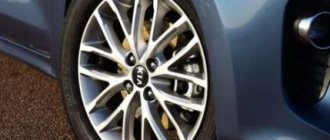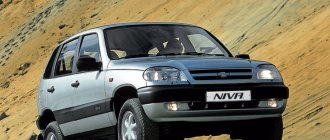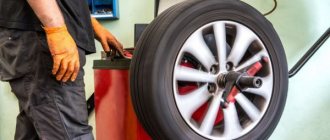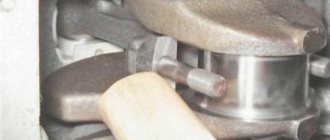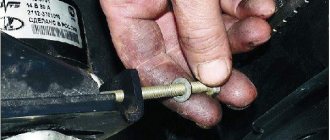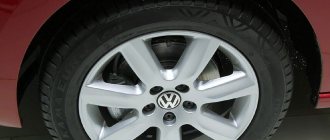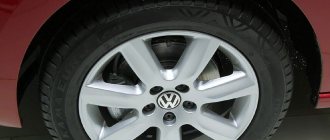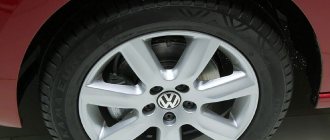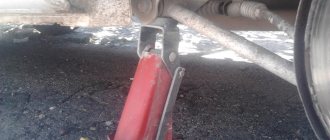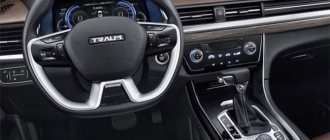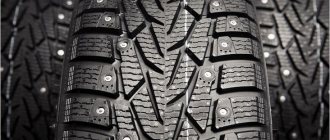The choice of protectors determines the controllability of the vehicle, the duration of its operation, stability and quality of traction. Therefore, before moving on to installation, you need to understand what kind of tires you need to buy, what consequences await you if installed incorrectly, and how not to get into trouble. In the article we will talk about directional tires and look at: what they are, how to install tires correctly, choose rubber with an arrow pattern (and without it) on the tread, we will talk about ways to install wheels with a choice of direction.
Types and their classification
Regardless of the season, there are several types of tires that differ in design and functionality. To understand what type is in front of you, you can evaluate:
- markings on the side;
- tire relief.
It is worth knowing exactly what tires are on your car. This is necessary for personal safety and to save time in the service if you decide to buy a new kit or need emergency assistance. Let's look at each type in detail.
Non-directional tires
Such protectors are considered classic. There is no fundamental difference in how to install the tires (in which direction); they are equally suitable for installation on the front and rear axles.
Recently, symmetrical tires were considered the most common; later, their asymmetrical appearance appeared and gained great popularity. Nowadays, non-directional tires are often included as standard equipment at the factory. The advantages include:
- low cost;
- fairly good off-road performance;
- stability on different types of road surfaces - asphalt, paving stones, country roads;
- excellent behavior at high speed;
- produce little extraneous noise;
- The ease of tire fitting is precisely because there is no need to determine the direction of the tire if there is no arrow; they can be placed on either side.
The main disadvantage of this type is considered to be poor adhesion to wet asphalt and wet soil. Thus, this is an average universal option.
Example of a tread in the photo:
Directional tires
They have a pattern indicating the direction of rotation. The efficiency of such tires will be optimal only if they are installed at the correct course. In the symmetrical version, the stripes are directed from the periphery to the center, and in asymmetrical models they are mirrored. In both cases, there is a marking on the sidewall with the inscription Rotation, which means “rotation” in English.
Advantages:
- excellent contact with the road in any weather - snow, rain, frost;
- reduction in braking distance compared to the previous version;
- an ideal solution for winter driving - accumulations of snow and dirt are collected and discharged along grooves from the center to the periphery;
- simple controllability of the steering wheel, holds the course well and does not deviate from it;
- high speed.
There are also some disadvantages:
- increased noise when driving on dry asphalt, especially with symmetrical furrows;
- the master must know how to correctly position the wheels on the tread, otherwise all the advantages that the pattern has will be lost;
- off-road, the handling advantages are invisible;
- asymmetrically oriented tires are rarely used, because few people want to carry 2 spare tires at once due to their separation into right and left;
- retail price is slightly higher than the non-directional alternative;
- It is not advisable to bead the tire from one side to the other.
Asymmetrical pattern
Due to the lack of symmetry, the protectors self-clean from dirt and water. It is worth paying special attention to two details that you will need to know during installation:
- Outdoor. It is marked Outside. It is responsible for ease of control and lane keeping. There are fewer lamellas and grooves, the pattern is smoother, but the rubber crumb and cord are dense, which provides better grip on the asphalt and an increase in the contact patch.
- Internal. It is marked Inside. This part is responsible for draining water, slush, snow, and dirt. On this side, the tread pattern is brighter, which is necessary for excellent handling and stable cornering.
A significant drawback that experts highlight is the mandatory installation of the tread according to the factory markings. You cannot accidentally confuse the direction or throw the tire from one side to the other. There should even be two reserves - right-hand and left-hand.
But the model has more positive qualities, among them:
- Excellent stability in the strip.
- There is virtually no hydroplaning effect. This occurs when some traction is lost during rain. Due to the deep grooves on the tread, the fluid drainage function works effectively.
- Ideal cornering, even at high speed.
- Shorter braking distance.
- High controllability.
Let's summarize: the presence of stepped grooves on tires with asymmetric tread increases the level of wheel grip. These tires perform best at high speeds on asphalt. These conditions give them the opportunity to demonstrate all their advantages clearly.
Our production
Wheels with a symmetrical pattern: how to install them correctly
Such protectors are suitable for owners of cars of different sizes. Tires are cheaper than asymmetrical ones, but at the same time have a fairly high level of comfort and safety. From the name it is already clear that the inner part of the tread in a mirror image repeats the outer side.
Let's consider the advantages:
- Affordable price.
- Fairly high quality.
- Good handling.
- Very simple tire fitting. It doesn't matter which side the tires are on. Accordingly, the spare tire can fit absolutely any wheel.
The main disadvantage of such tires is that they are not very stable on wet roads.
When we have dealt with the main types of tires, it is important to note one nuance: never put different types of models on a vehicle. Sometimes drivers try to improve ride quality, for example, by mounting an asymmetrical pair on the front wheels and a symmetrical pair on the rear wheels. Know that such actions will only spoil the vehicle’s stable behavior on the road and lead to poor handling.
How to correctly place tires on the left side in the direction of travel
The right- and left-hand position of the tires only matters for asymmetrical models, since their inner and outer parts are not similar to each other and perform different functions. In order not to confuse buyers, modern left-handed tires are marked Left. If it is not there, then on the left will be the tire with the arrow pointing straight, and the inner tread is more rugged, with a plentiful number of grooves.
Tires for right wheels
Their sides should be marked Right. If it is absent, you need to ensure that if the axis is in the correct position, there is a smoother edge on the outside. It may have OUTSIDE engraved on it.
It is very important not to confuse how to correctly place the rubber on the wheels in the direction of the tire tread pattern in asymmetrical models, as this can lead to skidding when turning, as well as poor stability on the road during precipitation.
Introduction
When choosing good tires, you are often faced with the problem of not only a huge number of models, but also a variety of tread patterns, which you also need to understand. One of the most popular patterns is the traditional directional one, which has been used on the tread surface of a wide variety of tires for many decades. What are directional tires and why are they still in demand not only among car enthusiasts, but also among professional motorcycle racers? In this article we will reveal all the secrets and technologies of directional tires, and also tell you how to install them correctly. Here, nuances and discoveries await us at every step.
Seasonality of tires and rules for their installation
First of all, let's look at the markings. The side of the tire may have the following symbols:
- “M+S” or “M&S” - this does not indicate the season and usually means that such vehicles can be used off-road, mud, and slush. The tread has very deep grooves that help drain away contaminants.
- If it says WATER, RAID, AQUA, then this tread has very good grip on wet surfaces.
- For winter options it's even easier. They have a snowflake or the English word Winter on the sidewall.
- You can read All SEASON, ROAD+WINTER or ANY Weather on all-season.
The seasonal setting is no different from the general rules. Carefully look at the direction of the arrow, and if there is none, at the location of the grooves.
What's the result?
Given the information above, there are a number of things to consider when choosing tires. First of all, it is important to take into account the operating conditions of the vehicle. For example, if the owner actively uses the car and drives mainly on dry roads over long distances, choosing directional tires will not always be the best option. In this case, it is optimal to choose an asymmetric tread.
One way or another, the main condition is to follow all the rules and recommendations for installing directional and asymmetrical tires. In this case, driving a car will be comfortable and safe, and a properly installed winter or summer tire will be fully capable of realizing the full potential put into it by engineers and designers.
What does tire marking mean, deciphering tire markings and symbols on the tire. Basic designations, additional designations, American markings.
Designation and interpretation of the tire speed index, tire load index. Table of index and load, features of American tire markings.
An exclamation mark on the dashboard lights up: what does an exclamation mark on a yellow background mean, an exclamation mark on a red background, diagnostics.
What does the concept of engine volume mean? Determination of engine displacement. Car classes depending on the volume of the internal combustion engine, the pros and cons of a large engine volume.
Icons on the dashboard: symbols and explanation of car instrument panel icons. Types of icons and indicators, what do the lights on the panel mean.
Transmission oil: properties, differences, features, tasks and classification of transmission oils. How to choose gear oil, recommendations.
Source
Consequences of improper tire installation
In case of poor quality work, installation errors, inappropriate protector sizes and non-compliance with the rules, you will notice:
- aquaplaning of a car on wet surfaces;
- not very good car handling;
- less contact with the road;
- uneven tire wear;
- increase in braking distance;
- acceleration duration.
Viatti Brina Nordico
The combination of advanced technology and high-quality rubber alloy guarantees the asymmetrical tire excellent performance and durability.
The model is distinguished by reinforced blocks on the outside, which is confirmed by the inscription Outside. At the same time, the direction of the spikes is also visible - upon careful examination, the central part of the working surface is elongated in the direction of movement of the machine.
Recommendations for installing directional tires
If you decide to install it yourself, look for the inscription ROTATION on the sides of the tread, that is, “rotation”. There is usually an arrow next to it. It is very easy to install tires along the specified vector.
If you do not find such markings, you can take a different route. The peculiarity of directional wheels is that the pattern on the tires is arranged in a herringbone or wedge pattern. The top-acute corner of the pattern should be directed forward in movement.
Here are some more tips:
- even after contacting a car repair shop, be sure to check the compliance of the markings yourself;
- after reloading, do not forget to go for balancing or do it yourself;
- Another mandatory check is air pressure.
Useful tips
Please note that if asymmetric tires or tires with a directional pattern (directional tires) are installed incorrectly on a vehicle, the performance of the tire will noticeably deteriorate. The car will handle and brake worse, maneuverability will deteriorate, aquaplaning may occur, driving noise will increase, and wear on the rubber itself will noticeably increase.
In fact, expensive asymmetrical or directional tires will perform very poorly on the road. For this reason, it is important to ensure that the tires on the rims are installed correctly. In practice, in some cases, inexperienced car enthusiasts or tire service workers may make mistakes by confusing the sides or direction of rotation when installing tires.
How to correctly install tires on a rim according to the marks
When buying tires, many drivers pay attention to the multi-colored markings on the sidewalls. The paint wears off quickly in the first weeks of use, but it can help with tire fitting. What color is it and what does it mean:
- Yellow. It indicates the easiest place, usually located opposite the air injection nipple valve. This simple mark makes the balancing system easier.
- Red. This, on the contrary, is the hardest point of the wheel. It should be where "L" is indicated on the disk.
- White. This is the most flexible part. The designation is necessary for car manufacturers and assemblers.
All tire fitters are familiar with the different color markings and can help you decipher them.
How to set the “winter” correctly
In Russia, at the legislative level (TR TS 018/2011), the need to replace the summer set of tires with winter ones is established with the onset of cold weather. Their main differences are the quality of the rubber mixture and the presence of studs. This allows for increased stability on snow and ice. You should “change your shoes” in advance, at the first frost, or even better – a week before them. According to traffic rules, driving in the “winter” is prohibited in June, July and August, and the use of summer tires is prohibited in the winter months.
When contacting a tire shop, pay attention to:
- Inspecting the sidewalls for cuts, cracks or foreign objects.
- Determining the direction of the tires - “herringbone” forward. If you break this rule, you may completely lose control on a snowy road.
- Checking the stable position of the studs. They shouldn't fall out. To check this, run it at low speed.
- Stand alignment and balancing.
Design Features
The structural features of rubber are distinctive features that increase the driving characteristics of the vehicle. It is important to understand them in order to choose the right replacement tires.
Tubeless, in case of a puncture they retain elasticity for a long time. The rubber tightens around the stuck object. Does not overheat when moving, due to heat removal by the open (metal) part of the rim. In contrast to the tube type, there are increased requirements for the rims, the need to apply additional sealant at the junction of the rim and rubber, and the complexity of installation. Tubeless ones are used more often; if mounted correctly, they have high wear resistance.
The difference between bias-ply and radial tires can only be correctly determined by the markings. Radial - r. Diagonal - do not have a letter index. You can understand the markings of diagonal ones by the presence of the TT designation - operation with a camera. Those who value speed need to understand the differences.
Is it possible to install tires with different treads?
Sometimes car owners are more concerned about savings than safety and buy only 1 tire instead of replacing the entire set. As a result, the car sits on tires with different patterns. But already in the traffic rules it is noted that it is strictly forbidden to put wheels with different patterns on the same axle (front or rear). According to car enthusiasts, sometimes this is acceptable.
But this is definitely a bad idea because:
- The sipes and grooves are different, and the braking characteristics (speed and braking distance) are also significantly different. In an emergency stop, this can cause a skid and lead to an accident.
- Road grip and hydroplaning will also vary, which is very dangerous when driving fast.
- The treads wear unevenly, as rubber compounds of different quality are used.
- All tests and, accordingly, indicators declared by world-famous manufacturers are based on compliance with the condition of a complete set of tires.
The whole truth about the Viatti tire brand
I did a little research and found out that tires are indeed produced in the petrochemical complex of the OJSC Tatneft holding. Previously, tires for new passenger cars from the AvtoVAZ and GAZ plants were produced there. In July 2002, a management company was created, and the plant came under the control of this company. The plant received its next round of development in 2005. Then an agreement was reached between the OJSC Tatneft holding and the famous German tire brand Continental to launch a new tire production. A German named Wolfgang Holzbach played a significant role here, then he worked for the Continental brand as vice president for the development of international business projects of the company.
Thus, Wolfgang Holzbach began work as deputy director of Management Company Tatneft-Neftekhim LLC, he is involved in monitoring production and increasing the efficiency of people. Under his leadership, the plant started up almost from scratch. In one of his interviews, he convinces that the plant in Tatarstan is modern and uses high-quality technologies. And employees undergo advanced training, including at the Continental base in Germany. The plant's products are intended for trucks and buses and are supplied within Russia and to European countries.
It’s not for nothing that I talk a lot about this German here. The Viatti brand appeared thanks to him. They write that he had long dreamed of creating a new tire brand. The man said it, the man did it! There are very few details here; on the Internet they write about the same thing everywhere. They decided to position the Viatti brand as a premium class. The design was ordered from Italian craftsmen related to the Pirelli brand, and production was established at a new site in Nizhnekamsk. The Viatti tire production line is entirely made of German equipment, production automation is almost 100%. The result was Italian-German-Russian tires. But adapted to Russian roads and climate. The Viatti model range includes winter non-studded (Brina, Vettore Inverno), winter studded (Brina Nordico and Bosco Nordico), all-season (Bosco A/T) and summer tires (Strada Asimmetrico).
Russian consumers may have noticed tires of this brand, for example, on the new Skoda Octavia sold at official dealers. And this means recognition of the quality of the tires, because Volkswagen will not install bad ones on the cars of its holding company. Meticulous automotive journalists tested some tire models. Their skeptical general conclusion is that Viatti tires are unlikely to be installed en masse on premium cars, but for most foreign cars they will be a good choice.
However, these tires continue to be promoted as premium. Viatti sponsors the GT Russian Team Viatti at the Blancpain GT Series international races. The same thing that bloggers often write about. This is a race of premium sports cars of the GT class (Gran Turismo), such as top models from Audi, McLaren, Lamborghini, Aston Martin, Mercedes-Benz, Ferrari and others. These races replaced the FIA GT1 World and FIA GT3 European Championships. The Blancpain GT Series has two formats: Sprint (one-hour sprint) and Endurance (endurance racing from 6 to 24 hours). Recently, the GT Russian Team Viatti team won 1 team place in the sprint championship. Members of the racing team take part in testing new Viatti tire models and give their recommendations to the plant engineers.
Replacement procedure: what pattern should you use for the wheels?
Tire fitting algorithm:
- Unscrew the bolts - loosen them a little, but do not remove them completely.
- Raise the car on a jack.
- Secure the body in a suspended position.
- Remove the old tire and install a new one, pre-balanced, taking into account the direction of travel - with the wedges forward.
- Retighten the fasteners.
- Lower the car.
Car owners in most cases prefer to contact a tire service. In addition, other auxiliary procedures can be carried out immediately at the service station, for example, balancing, pumping up air.
Is it possible to swap wheels with pressure sensors?
In most cases, pressure sensors immediately or after 2-3 km of run restore communication (are registered) automatically with any rotation of the wheels. Otherwise, problems would also arise during seasonal replacement of tires, which would become a problem for the owners and reputation of a particular brand.
From experience, sometimes it is necessary to inflate rearranged wheels to increased pressure values - 2.3-2.6, and then lower them to normal in order to restore the operation of the sensors.
In all cases, the most accurate recommendations are set out in the Operating Instructions for each specific car model.
Replacement scheme
Previously, it was believed that wheels had to be installed in a certain order. That is, during the season there should be one arrangement, and at the next “change of shoes” - another. All this had one goal - to ensure uniform wear on all elements of the kit. Now this remains relevant only for non-directional asymmetrical models, which can be placed in any way. Let's look at an image with an approximate shift diagram:
Please note: with correct wheel alignment, tire wear will occur evenly, and the indicated diagram will not be useful to you.
Selection of tools for work
To install studs on rubber that does not have holes, you need to prepare an electric drill, as well as a tubular drill. When drilling with such a drill occurs, the chips are hidden inside, and the drilled areas do not need to be blown out.
To ensure that the protrusion of the studs above the tire surface is always the same, a special depth limiter is installed. They should not be recessed too deeply, otherwise they will simply lose their functionality.
To install studs on your wheels yourself, you need to use a pneumatic gun that works in conjunction with an air compressor. The steel legs of the gun under a strong air flow expand the hole, the spike is driven inside. To stud a wheel you will need:
- Pliers.
- Hammer.
- Soap solution.
- Spikes (claws).
Helpful advice. To accurately adjust the stud extension, all you need is a hammer and a steel plate.
